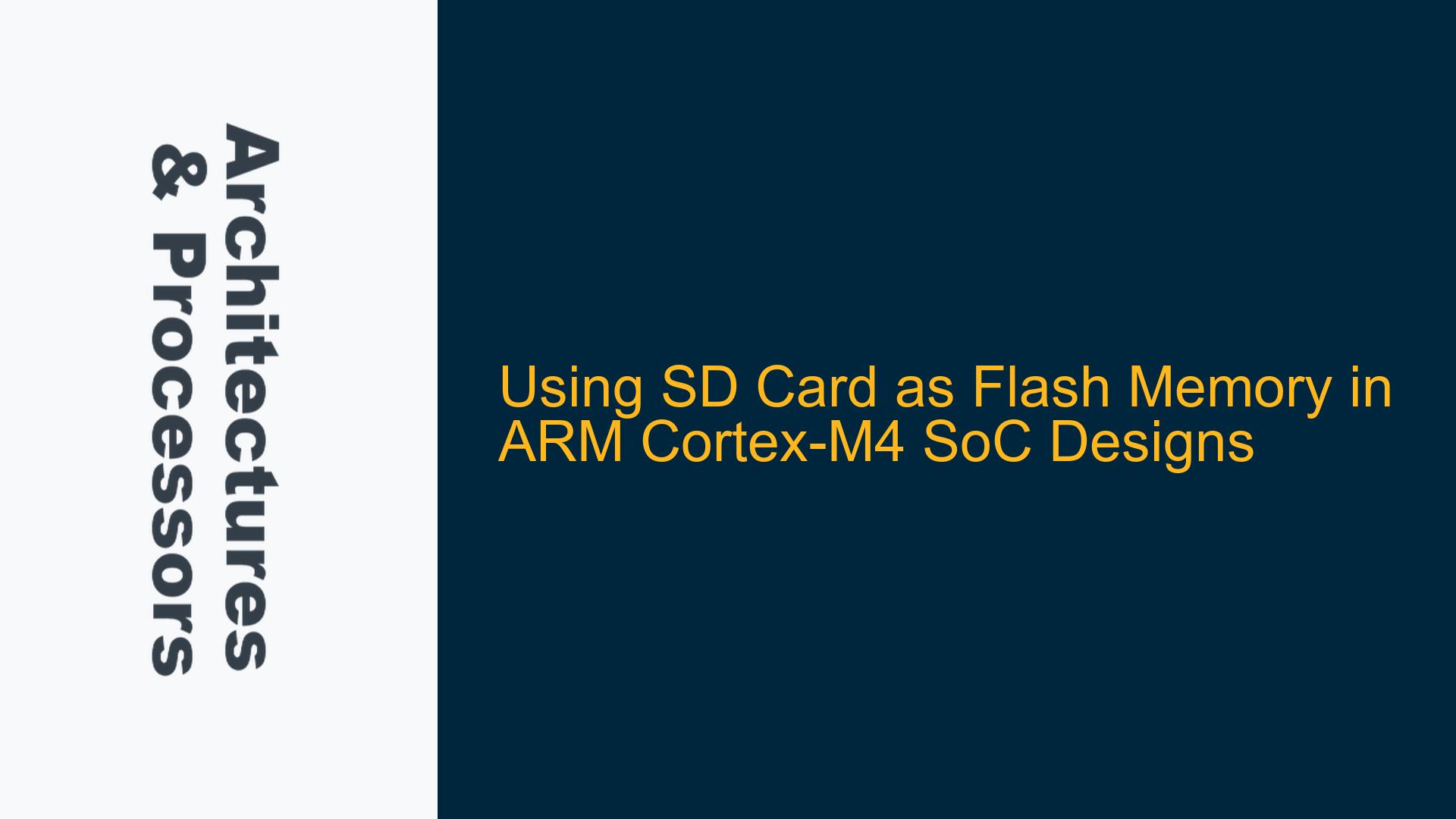ARM Cortex-M4 SoC Memory Constraints and SD Card Utilization
In ARM Cortex-M4-based System-on-Chip (SoC) designs, memory constraints often pose significant challenges, especially when external flash memory is unavailable or impractical. One potential solution involves repurposing a MicroSD card as flash memory, leveraging the Quad-SPI interface typically used for flash memory communication. This approach requires careful consideration of both hardware and software aspects to ensure proper functionality and performance.
The Quad-SPI interface, designed for high-speed communication with serial flash memory, can be adapted to interface with an SD card through a MicroSD Memory Card Connector. However, this adaptation is not straightforward due to differences in protocol, timing, and data organization between traditional flash memory and SD cards. The SD card operates under the Secure Digital (SD) protocol, which includes initialization, command-response mechanisms, and block-based data access, contrasting with the direct memory-mapped access typical of Quad-SPI flash memory.
To utilize an SD card as flash memory in an ARM Cortex-M4 SoC, the system must handle several key tasks: initializing the SD card, managing data read/write operations, and ensuring data integrity. The initialization process involves sending specific commands to the SD card to set it up for SPI mode, which is compatible with the Quad-SPI interface. Once initialized, the system can perform block-based read and write operations, treating the SD card as a storage medium.
However, this approach introduces complexities such as managing file systems, handling wear leveling, and ensuring data consistency. Unlike traditional flash memory, SD cards require a file system (e.g., FAT32) to organize data, which adds overhead and complexity to the software stack. Additionally, SD cards have limited write endurance, necessitating wear leveling algorithms to distribute write operations evenly across the memory cells.
Protocol Mismatch and Initialization Challenges
The primary challenge in using an SD card as flash memory lies in the protocol mismatch between the Quad-SPI interface and the SD card’s native communication protocol. The Quad-SPI interface is optimized for direct memory access, while the SD card operates under a command-response protocol that requires specific initialization sequences and command handling.
The SD card initialization process in SPI mode involves sending a series of commands to the card to set it up for communication. This process includes sending the CMD0 command to reset the card, followed by the CMD8 command to check the card’s voltage compatibility. The card then enters the initialization state, during which it responds to the CMD55 and ACMD41 commands to complete the setup. This sequence must be carefully implemented in the SoC’s firmware to ensure successful initialization.
Another challenge is the difference in data access methods. Traditional flash memory allows direct memory-mapped access, enabling the CPU to read and write data as if it were accessing internal memory. In contrast, SD cards require block-based access, where data is read and written in fixed-size blocks (typically 512 bytes). This block-based access necessitates additional software layers to manage data transfers, increasing the complexity of the system.
Furthermore, the SD card’s wear leveling and error correction mechanisms differ from those of traditional flash memory. SD cards incorporate internal controllers that manage wear leveling and bad block management, but these mechanisms are not directly accessible to the host system. This lack of control can lead to performance bottlenecks and data integrity issues, especially in applications with frequent write operations.
Implementing SD Card as Flash Memory with Quad-SPI Interface
To successfully implement an SD card as flash memory in an ARM Cortex-M4 SoC, a comprehensive approach is required, encompassing both hardware and software considerations. The following steps outline the process:
-
Hardware Configuration: Ensure that the Quad-SPI pins on the ARM Cortex-M4 SoC are correctly connected to the MicroSD Memory Card Connector. The Quad-SPI interface typically consists of six signals: CLK, CS, IO0, IO1, IO2, and IO3. These signals must be mapped to the corresponding pins on the SD card connector, with appropriate pull-up resistors and decoupling capacitors to ensure signal integrity.
-
Firmware Initialization: Develop firmware to initialize the SD card in SPI mode. This involves sending the CMD0 command to reset the card, followed by the CMD8 command to check voltage compatibility. The card then enters the initialization state, during which it responds to the CMD55 and ACMD41 commands to complete the setup. This sequence must be carefully implemented to ensure successful initialization.
-
Block-Based Data Access: Implement block-based read and write operations to interact with the SD card. The firmware must handle the command-response protocol, sending the appropriate commands (e.g., CMD17 for single block read, CMD24 for single block write) and managing the data transfer process. The data is transferred in fixed-size blocks, typically 512 bytes, requiring the firmware to manage buffer sizes and data alignment.
-
File System Integration: Integrate a file system (e.g., FAT32) to organize data on the SD card. The file system provides a logical structure for storing and retrieving files, enabling the system to manage data more efficiently. The file system layer must be implemented in the firmware, handling tasks such as directory management, file creation, and data read/write operations.
-
Wear Leveling and Data Integrity: Implement wear leveling algorithms to distribute write operations evenly across the SD card’s memory cells, extending the card’s lifespan. Additionally, incorporate error detection and correction mechanisms to ensure data integrity, especially in applications with frequent write operations.
-
Performance Optimization: Optimize the system’s performance by minimizing latency and maximizing throughput. This involves tuning the Quad-SPI interface’s clock speed, optimizing the firmware’s command handling, and managing buffer sizes to reduce overhead. Additionally, consider using DMA (Direct Memory Access) to offload data transfer tasks from the CPU, improving overall system performance.
-
Testing and Validation: Thoroughly test the system to ensure proper functionality and performance. This includes testing the initialization sequence, data read/write operations, file system integration, and wear leveling mechanisms. Use simulation tools and hardware testing to validate the system’s behavior under various conditions, ensuring reliability and robustness.
By following these steps, the ARM Cortex-M4 SoC can effectively utilize an SD card as flash memory, addressing the memory constraints and enabling the system to operate with the required performance and reliability. This approach requires careful consideration of both hardware and software aspects, but with proper implementation, it can provide a viable solution for memory-limited SoC designs.






